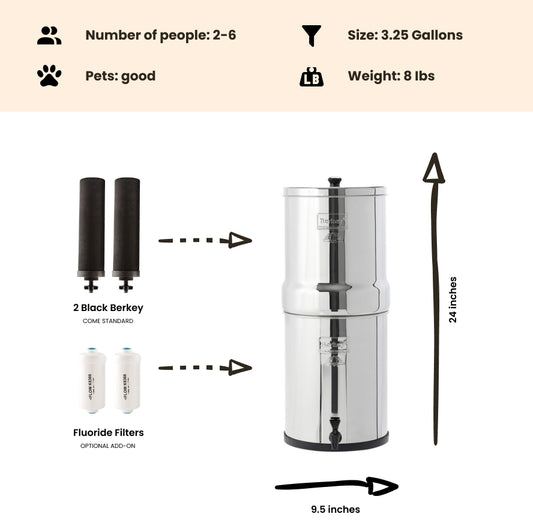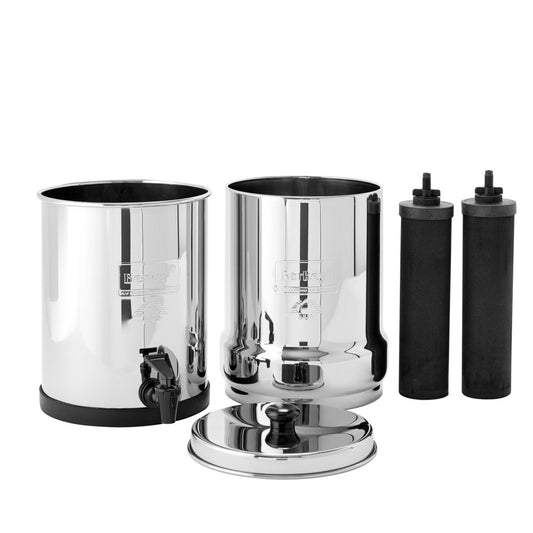
Everything You Need to Know About Mercury in Water: Health Risks, Testing, and Solutions
By Dan DeBaunShare
Everything You Need to Know About Mercury in Water: Health Risks, Testing, and Solutions
Mercury is a heavy metal that occurs naturally in the environment, but when it makes its way into drinking water, it can pose a serious health risk. Mercury exposure, especially over time, can damage the nervous system and vital organs. It can also negatively impact child development.
Fortunately, there are effective ways to protect your family from exposure to mercury in drinking water.
Knowledge is the first step, which is why we created this comprehensive guide to equip you with the information you need to protect yourself and your loved ones. Keep reading to explore all aspects of mercury in drinking water and learn how to deal with it effectively.
In this article, you’ll learn more about:
Where Mercury Comes From and Why It’s Harmful?
Mercury is a heavy metal found in air, soil, and water. Naturally occurring mercury can volatilize and evaporate from the Earth’s crust, or it can be released in large amounts during human activities such as the combustion of fossil fuels, industrial processes, and mining. Once mercury enters the water supply, it becomes a public health concern.
Mercury is toxic even at low levels of exposure. As mercury bioaccumulates in the body over time, long-term exposure can lead to irreversible damage. Understanding where mercury comes from and how it behaves is essential to keeping your water and your family’s health safe.
How Mercury Gets into Drinking Water
Mercury can find its way into drinking water through a variety of pathways—some natural, others driven by human activity.
In nature, events such as volcanic eruptions and the gradual weathering of mercury-rich rocks can release mercury into the environment.
However, the biggest culprits are often human-made: coal-burning power plants, mining operations, and industrial facilities all emit mercury as a byproduct. Even everyday items such as old thermometers, fluorescent bulbs, and batteries can become sources of contamination when not disposed of properly.
Once mercury is released, it can get carried into waterways with stormwater runoff, or it can leach through soils to contaminate underground aquifers. These multiple entry points mean that mercury contamination is not just a rural or industrial issue—it affects both surface water and groundwater, posing a risk to public water systems and private wells alike.
Types of Mercury You Might Encounter
Mercury exists in several forms, and each poses unique risks:
- Elemental Mercury: We can often find elemental mercury in thermometers or industrial equipment. While it is not usually water-soluble, it is dangerous if vaporized and inhaled.
- Inorganic Mercury Compounds: Inorganic mercury compounds are formed when mercury combines with elements like chlorine or sulfur. These compounds are water-soluble and, therefore, more likely to appear in drinking water.
- Organic Mercury: Exposure to organic mercury, such as methylmercury, typically occurs from the ingestion of contaminated fish and shellfish, which tend to bioaccumulate mercury in their body tissue, but it can also leach into water sources.
Health Risks Associated with Mercury Exposure
The risks associated with mercury exposure are serious and increase with prolonged exposure:
- Neurological damage: Mercury affects the brain and nervous system, with children and developing fetuses being particularly vulnerable.
- Kidney damage: Long-term exposure to mercury can impair kidney function.
- Developmental delays: Prenatal mercury exposure can lead to cognitive and motor development issues.
- Immune system suppression: Mercury can disrupt the immune system, interfering with the body’s ability to fight disease.
- Minamata disease: Minamata disease is a potentially fatal disease caused by extreme mercury poisoning. It was first reported in the city of Minamata, Japan, in 1956, where methylmercury released in industrial wastewater poisoned local inhabitants who ate contaminated fish and shellfish.
Young children, pregnant women, and individuals with compromised immune systems are especially vulnerable to the health risks associated with mercury exposure.
Testing Your Water for Mercury
If you rely on a private well or suspect your drinking water may be contaminated with mercury, testing your water is a crucial first step.
There are two options for testing your water for mercury:
- DIY Test Kits: Affordable and convenient, but typically less accurate than a lab test. Ideal for quick checks to give you peace of mind.
- Laboratory Testing: Offers precise results and can detect even trace amounts of mercury. We recommend lab testing if you live in a high-risk area or have ongoing concerns.
If your home is near an industrial area or a former mining site, regular testing is essential.
Regulations and Safe Limits for Mercury in Drinking Water
To minimize the public health risk, several agencies have set regulatory limits on mercury in drinking water:
- The U.S. Environmental Protection Agency (EPA): The EPA has set the maximum contaminant level (MCL) for mercury at 2 parts per billion (ppb).
- The World Health Organization (WHO): The World Health Organization recommends a guideline value of 6 micrograms per liter.
- U.S. Food and Drug Administration: The FDA’s safety limit for mercury in bottled water is at 2 parts per billion (ppb), mirroring that set by the EPA for drinking water.
- State and local agencies: Maximum acceptable concentrations for mercury can vary from state to state or country to country. For example, a maximum limit of 0,001mg/L (1 ppb) has been established in Canada.
These limits are based on scientific research and aim to prevent health risks from long-term exposure.
Can Your Water Filter Remove Mercury?
Not all water filters are equipped to handle heavy metals like mercury, which means relying on a standard carbon filter might leave you with a false sense of security. While basic carbon filters can reduce certain odors and chlorine, they often fall short when it comes to trapping heavy metals.
To effectively reduce mercury, look for filtration systems that combine activated carbon with ion exchange technology, which allows the filter to chemically bind and trap mercury particles.
Reverse osmosis (RO) systems are another highly effective option, as they force water through a semipermeable membrane that blocks even microscopic contaminants, including mercury.
It’s also crucial to choose filters that have been independently tested to meet EPA and ANSI/NSF standards for heavy metal reduction.
Lastly, always check the manufacturer's specifications to confirm that the filter is explicitly rated for mercury removal, as performance can vary widely between products.

How Berkey Water Filters Handle Mercury
Black Berkey filters are designed to tackle a wide range of contaminants, including mercury. Here's how they work:
- Activated Carbon + Proprietary Media: The Black Berkey purification elements combine high-grade carbon with ion exchange resin to trap mercury and other heavy metals.
- Independent Testing: Berkey filters have been tested to reduce heavy metals, including mercury, by 99.99%, reducing levels to well below the EPA’s safe limits.
- Long Lifespan: Each filter element can treat thousands of gallons of water, offering long-term protection and peace of mind.
What to Do If You’re Concerned About Mercury In Your Water
If you're worried about mercury in your drinking water, there are practical and effective steps you can take to protect your family's health:
- Test your water: Begin by testing your water, using a reliable method that will give you accurate results. While at-home test kits can offer quick insights, professional laboratory testing is the most accurate and can detect even trace levels of mercury. This will provide you with a clear understanding of whether contamination is present and how serious the issue is.
- Research your area: Learn about local sources of contamination by looking into your area’s environmental history and current risk factors. If you live near industrial zones, old mining sites, or areas with coal-fired power plants, the chances of mercury contamination may be higher. Your state’s environmental or health department often provides water quality reports that can be helpful.
- Choose the right filter: Not all water filters remove mercury, so it’s important to invest in a system that is specifically designed and tested to do so. Look for filters that use activated carbon with ion exchange or reverse osmosis technology, and check that the system meets EPA and NSF/ANSI standards for heavy metal reduction.
- Maintain your system: Even the best filter won’t be effective if it’s not properly maintained. Follow the manufacturer’s recommendations for replacing filter elements, and keep an eye on the system’s performance indicators to ensure it’s working as it should.
- Stay informed: Water quality can change over time, so it's essential to stay updated. Follow alerts and guidance from your local water authority or public health department, and retest your water periodically, especially after major weather events or changes in local industrial activity.
Taking these steps not only helps you manage the risk of mercury exposure but also gives you greater confidence in the quality and safety of the water your family drinks every day.
Take Action to Protect Your Family from Mercury
Mercury in drinking water is a real but manageable threat. By understanding where it comes from, how it affects our health, and what tools are available to combat it, you can take meaningful steps to protect your household.
Explore Berkey filter solutions to see how they can help keep your drinking water safe. And don’t forget to check out our blog for more insights into common water contaminants and how to eliminate them from your home.
FAQ: Mercury in Drinking Water
-
Is mercury in drinking water safe?
Only at extremely low levels. The EPA has set the safety limit for mercury in drinking water at 2 parts per billion (ppb). -
How fast is mercury poisoning?
Acute poisoning is rare and requires high doses. Most cases are due to chronic exposure over time. -
Is mercury poisoning permanent?
Some effects, especially on the nervous system, can be irreversible, especially in children and fetuses. -
What are the symptoms of mercury in water?
Symptoms may include tremors, memory loss, numbness, vision changes, and developmental delays in children. -
What is the disease caused by mercury in water?
Minamata disease is caused by severe mercury poisoning from consuming contaminated fish or contaminated water. -
How do you remove mercury from drinking water?
Use filters with activated carbon and ion exchange or reverse osmosis systems. Berkey filters are an effective option. -
How to detect mercury in water?
Use a certified test kit or send a sample to a lab for precise analysis. -
Is there mercury in bottled water?
Bottled water can contain mercury. However, it has to meet USFDA standards, which stipulate it cannot contain more than 2 parts per billion (2 micrograms per liter). To be on the safe side, always check that the water has been tested and certified to meet safety requirements.
-
Regular price $234.00 USDRegular priceUnit price / per
-
Regular price $327.00 USDRegular priceUnit price / per
-
Regular price From $367.00 USDRegular priceUnit price / per
-
Regular price From $408.00 USDRegular priceUnit price / per
-
Regular price From $451.00 USDRegular priceUnit price / per
-
Regular price From $478.00 USDRegular priceUnit price / per
-
Regular price $332.50 USDRegular priceUnit price / per
$350.00 USDSale price $332.50 USDSale

Dan DeBaun
Dan DeBaun is the owner and operator of Big Berkey Water Filters. Prior to Berkey, Dan was an asset manager for a major telecommunications company. He graduated from Rutgers with an undergraduate degree in industrial engineering, followed by an MBA in finance from Rutgers as well. Dan enjoys biohacking, exercising, meditation, beach life, and spending time with family and friends.
~ The Owner of Big Berkey Water Filters















